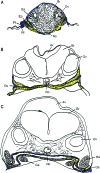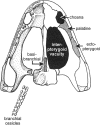Evolutionary and developmental origins of the vertebrate dentition
- PMID: 19422425
- PMCID: PMC2736119
- DOI: 10.1111/j.1469-7580.2009.01053.x
Evolutionary and developmental origins of the vertebrate dentition
Abstract
According to the classical theory, teeth derive from odontodes that invaded the oral cavity in conjunction with the origin of jaws (the 'outside in' theory). A recent alternative hypothesis suggests that teeth evolved prior to the origin of jaws as endodermal derivatives (the 'inside out' hypothesis). We compare the two theories in the light of current data and propose a third scenario, a revised 'outside in' hypothesis. We suggest that teeth may have arisen before the origin of jaws, as a result of competent, odontode-forming ectoderm invading the oropharyngeal cavity through the mouth as well as through the gill slits, interacting with neural crest-derived mesenchyme. This hypothesis revives the homology between skin denticles (odontodes) and teeth. Our hypothesis is based on (1) the assumption that endoderm alone, together with neural crest, cannot form teeth; (2) the observation that pharyngeal teeth are present only in species known to possess gill slits, and disappear from the pharyngeal region in early tetrapods concomitant with the closure of gill slits, and (3) the observation that the dental lamina (sensu Reif, 1982) is not a prerequisite for teeth to form. We next discuss the progress that has been made to understand the spatially restricted loss of teeth from certain arches, and the many questions that remain regarding the ontogenetic loss of teeth in specific taxa. The recent advances that have been made in our knowledge on the molecular control of tooth formation in non-mammalians (mostly in some teleost model species) will undoubtedly contribute to answering these questions in the coming years.
Figures





Comment in
-
'The integument story: origins, evolution and current knowledge'.J Anat. 2009 Apr;214(4):407-8. doi: 10.1111/j.1469-7580.2009.01051.x. J Anat. 2009. PMID: 19422422 Free PMC article. No abstract available.
Similar articles
-
The odontode explosion: the origin of tooth-like structures in vertebrates.Bioessays. 2010 Sep;32(9):808-17. doi: 10.1002/bies.200900151. Bioessays. 2010. PMID: 20730948 Free PMC article. Review.
-
The conundrum of pharyngeal teeth origin: the role of germ layers, pouches, and gill slits.Biol Rev Camb Philos Soc. 2022 Feb;97(1):414-447. doi: 10.1111/brv.12805. Epub 2021 Oct 13. Biol Rev Camb Philos Soc. 2022. PMID: 34647411 Free PMC article. Review.
-
Origin and evolution of gnathostome dentitions: a question of teeth and pharyngeal denticles in placoderms.Biol Rev Camb Philos Soc. 2005 May;80(2):303-45. doi: 10.1017/s1464793104006682. Biol Rev Camb Philos Soc. 2005. PMID: 15921053 Review.
-
Retention of fish-like odontode overgrowth in Permian tetrapod dentition supports outside-in theory of tooth origins.Biol Lett. 2019 Sep 27;15(9):20190514. doi: 10.1098/rsbl.2019.0514. Epub 2019 Sep 11. Biol Lett. 2019. PMID: 31506034 Free PMC article.
-
The ins and outs of the evolutionary origin of teeth.Evol Dev. 2016 Jan-Feb;18(1):19-30. doi: 10.1111/ede.12099. Epub 2014 Sep 15. Evol Dev. 2016. PMID: 25219878
Cited by
-
Development of teeth and jaws in the earliest jawed vertebrates.Nature. 2012 Nov 29;491(7426):748-51. doi: 10.1038/nature11555. Epub 2012 Oct 17. Nature. 2012. PMID: 23075852
-
The origin of vertebrate teeth and evolution of sensory exoskeletons.Nature. 2025 Jun;642(8066):119-124. doi: 10.1038/s41586-025-08944-w. Epub 2025 May 21. Nature. 2025. PMID: 40399678 Free PMC article.
-
Neopterygian phylogeny: the merger assay.R Soc Open Sci. 2018 Mar 21;5(3):172337. doi: 10.1098/rsos.172337. eCollection 2018 Mar. R Soc Open Sci. 2018. PMID: 29657820 Free PMC article.
-
Multiple epithelia are required to develop teeth deep inside the pharynx.Proc Natl Acad Sci U S A. 2020 May 26;117(21):11503-11512. doi: 10.1073/pnas.2000279117. Epub 2020 May 12. Proc Natl Acad Sci U S A. 2020. PMID: 32398375 Free PMC article.
-
Evolutionary aspects of the development of teeth and baleen in the bowhead whale.J Anat. 2017 Apr;230(4):549-566. doi: 10.1111/joa.12579. Epub 2017 Jan 10. J Anat. 2017. PMID: 28070906 Free PMC article.
References
-
- Adams AE. An experimental study of the development of the mouth in the amphibian embryo. J Exp Zool. 1924;40:311–379.
-
- Ahlberg PE, Smith MM, Johanson Z. Developmental plasticity and disparity in early dipnoan (lungfish) dentitions. Evol Dev. 2006;8:331–349. - PubMed
-
- Barlow LA, Northcutt RG. Embryonic origin of amphibian taste buds. Dev Biol. 1995;169:273–285. - PubMed
-
- Berman DS. A trimerorhachid amphibian from the upper Pennsylvanian of New Mexico. J Paleontol. 1973;47:932–945.
-
- Bjerring HC. A contribution to structural analysis of the head of craniate animals. Zool Scr. 1977;6:127–183.
Publication types
MeSH terms
LinkOut - more resources
Full Text Sources

